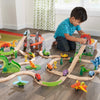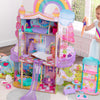Stages of Play: How Kids Should Play by Age

We’ve written about types of play before – like imaginative, constructive, and active play to name a few – but many parents wonder if there are stages of play too. As in, “Should my kid play a certain way by the time they reach a certain age?” Of course, all types of play evolve as kids get older (like clumsy toddling turning into full-out sprinting or tiny block towers becoming complex structures). But some of the most noticeable and predictable developments in play happen in social play.
In this post, we’re diving into the six recognized stages of social play with peers and when you can expect to see them!
Unoccupied Play: Birth to 3 months
When your newborn stares at objects with interest, they’re actually playing! Even if they don’t reach for those objects yet, they’re still attempting to figure out the world around them. And when they do start to reach for those objects, you may notice they don’t have any goals in mind yet; they’re likely to simply grab it and release it instead of trying to bring it to their mouth or manipulate it. This stage of play is known as “unoccupied play,” and, as you could probably guess, it doesn’t involve much social interaction at all. This is the shortest lived of all the stages.
Independent Play: 2+ Years
Independent play starts when a child really starts to engage with toys and objects and isn’t interested in interaction from peers or adults during that time. Instead, they’re focused on their own play. You’ll see their imaginations and focus grow during this type of play. Eventually, they’ll begin using items to represent other items (an important developmental milestone) and developing their own narratives for the play scenario. This stage can begin as early as a few months old, but it really peaks around age 2. Of course, independent play never truly goes away either. Even when kids become social butterflies, they’ll still enjoy playing by themselves occasionally.
Onlooker Play: 0 -2 Years
Like unoccupied play, onlooker play may not look like actual play to us. In this stage, kids tend to observe other children playing but don’t join in themselves. While you may feel like you need to encourage them to join, it’s perfectly okay for them to observe too. They’re likely enjoying the time, and they’re gaining valuable information about how older kids interact. These moments will help prepare them for more direct social play in the future.
Parallel Play: 2 - 3 Years
Ever notice how toddler are perfectly content being next to their little buddies… without actually doing anything with them? This is known as parallel play, and it occurs when kids are play near each other but not with each other. They may be working on similar activities or even follow each other around, but they don’t influence each other’s play yet.
Associative Play: 3-4 Years
This type of play is a step up from parallel play in terms of social interaction. In associative play, kids may talk to each other and influence each other’s activities but aren’t truly playing with the same things at the same time. For example, they might make suggestions for their friend’s play dough sculpture or try to copy it. Associative play is a great chance for kids to practice talking to one another and learning basic social norms before they begin more complex social play. You’ll usually see it begin around age 3 or a little sooner and last into age 4.
Cooperative Play: 4+ Years
When we think of “social play,” we mostly picture cooperative play, which emerges around age 4 or 5. This occurs when kids truly begin playing with each other as opposed to near each other. They’ll develop complex imaginative scenarios together and begin playing organized games with rules.
Keep in mind that most of these stages refer to how kids play with their peers, not necessarily with adults. Their play with you might look quite different as they likely have more confidence interacting with you, and you are able to give them more direction on how to play than a peer could. So if your two-year old loves to play pretend with you but not with kids their own age, don’t sweat it. You’re helping them gain the confidence, social skills, and language they’ll need to grow into the next stage of social play!














